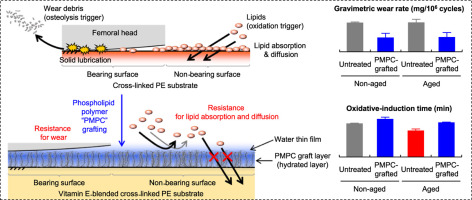Journal of the Mechanical Behavior of Biomedical Materials ( IF 3.9 ) Pub Date : 2017-12-30 , DOI: 10.1016/j.jmbbm.2017.12.036 Masayuki Kyomoto , Toru Moro , Shihori Yamane , Kenichi Watanabe , Masami Hashimoto , Sakae Tanaka , Kazuhiko Ishihara

|
Manipulating the surface and substrate of cross-linked polyethylene (CLPE) is an essential approach for obtaining life-long orthopedic bearings. We therefore proposed a bearing material comprised of an antioxidative substrate generated by vitamin E blending (HD-CLPE[VE]) with a poly(2-methacryloyloxyethyl phosphorylcholine) (PMPC)-grafted surface, and investigated its wear resistance and oxidative stability under accelerated aging and load bearing conditions. Neither the hydration nor friction kinetics of the molecular network structure of the PMPC-grafted surface or the HD-CLPE(VE) substrate were influenced by accelerated aging but rather exhibited high stability even under high oxidation conditions. The characteristics of the PMPC-grafted surface improved the wear and impact fatigue resistance of the HD-CLPE(VE) liner regardless of accelerated aging. Notably, the PMPC-grafted surface was found to affect the potential oxidative stability at the rim part of the acetabular liner. PMPC chains serve several important functions on the surface regardless of load bearing, such as high lubricity or low lipophilicity attributed to phosphorylcholine groups and/or surrounding water-fluid film, and suppression of lipid diffusion attributed to methacrylate main chains on the surface. Together, these results provide preliminary evidence that the PMPC graft layer and vitamin E-blended substrate might positively affect the extent of orthopedic implant durability.
中文翻译:

磷脂聚合物接枝层在承重条件下具有高耐磨性和抗氧化性
操纵交联聚乙烯(CLPE)的表面和基材是获得终身骨科轴承的一种必不可少的方法。因此,我们提出了一种轴承材料,该材料由抗氧化剂基质组成,该抗氧化剂基质是通过将维生素E共混(HD-CLPE [VE])与聚(2-甲基丙烯酰氧基乙基磷酰胆碱)(PMPC)接枝的表面生成的,并研究了其耐磨性和在加速条件下的氧化稳定性老化和承重条件。PMPC接枝表面或HD-CLPE(VE)基材的分子网络结构的水合动力学和摩擦动力学都不受加速老化的影响,但即使在高氧化条件下也表现出高稳定性。PMPC接枝表面的特性改善了HD-CLPE(VE)衬板的耐磨性和抗冲击疲劳性,而与加速老化无关。值得注意的是,已发现接枝PMPC的表面会影响髋臼内衬边缘部分的潜在氧化稳定性。无论负载如何,PMPC链均在表面上发挥一些重要功能,例如归因于磷酰胆碱基团和/或周围的水流体膜的高润滑性或低亲脂性,以及归因于表面上的甲基丙烯酸酯主链的脂质扩散受到抑制。在一起,这些结果提供了初步的证据,表明PMPC移植物层和维生素E混合的底物可能对整形外科植入物的耐用性产生积极影响。发现PMPC接枝表面会影响髋臼内衬边缘部分的潜在氧化稳定性。无论负载如何,PMPC链均在表面上发挥一些重要功能,例如归因于磷酰胆碱基团和/或周围的水流体膜的高润滑性或低亲脂性,以及归因于表面上的甲基丙烯酸酯主链的脂质扩散受到抑制。在一起,这些结果提供了初步的证据,表明PMPC移植物层和维生素E混合的底物可能对整形外科植入物的耐用性产生积极影响。发现PMPC接枝表面会影响髋臼内衬边缘部分的潜在氧化稳定性。无论负载如何,PMPC链均在表面上发挥一些重要功能,例如归因于磷酰胆碱基团和/或周围的水流体膜的高润滑性或低亲脂性,以及归因于表面上的甲基丙烯酸酯主链的脂质扩散受到抑制。在一起,这些结果提供了初步的证据,表明PMPC移植物层和维生素E混合的底物可能对整形外科植入物的耐久性产生积极影响。和抑制归因于表面上的甲基丙烯酸酯主链的脂质扩散。在一起,这些结果提供了初步的证据,表明PMPC移植物层和维生素E混合的底物可能对整形外科植入物的耐用性产生积极影响。和抑制归因于表面上的甲基丙烯酸酯主链的脂质扩散。总之,这些结果提供了初步证据,表明PMPC移植物层和维生素E混合的底物可能对整形外科植入物的耐用性产生积极影响。


























 京公网安备 11010802027423号
京公网安备 11010802027423号